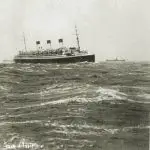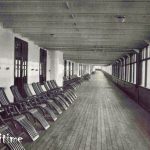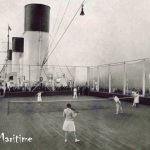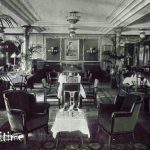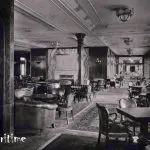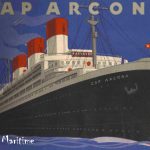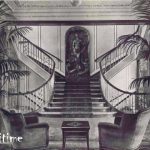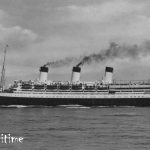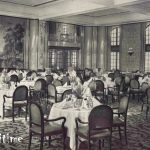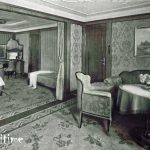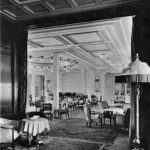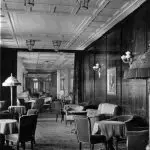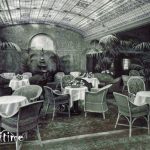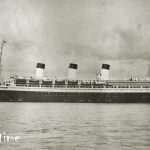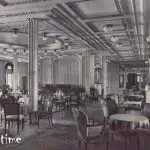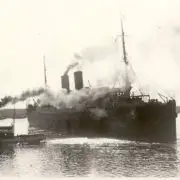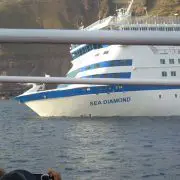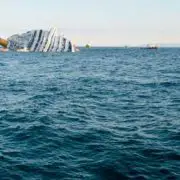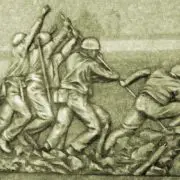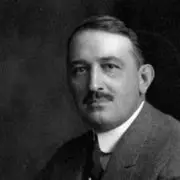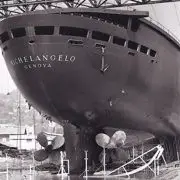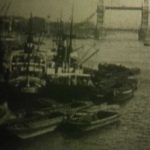The Cap Arcona
Perhaps the loveliest of the “forgotten” liners is Hamburg-Sudamerikanische’s Cap Arcona. She was conceived and built in the mid-1920s for service between Northern Europe and Argentina, a route every bit as prestigious as the better remembered North Atlantic run. She was born into a world of afternoon teas and Jazz modified for the Palm Court, and saw her service life terminated in a world of air raids and the Horst Wessel Song. Her last minute death, in May 1945, was beyond a doubt the single most regrettable maritime disaster of them all.
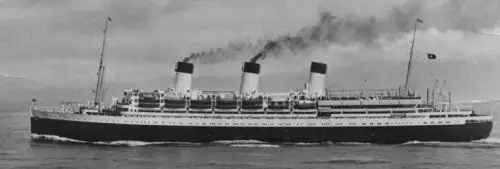 Presented here is a collection of photographs, dating to the pre-Nazi era, of the Cap Arcona and her lavish, airy interiors. Souvenirs of a better time, and of the era when Europe’s presence and influence in Buenos Aires, the Paris of the South, was at its strongest.
Presented here is a collection of photographs, dating to the pre-Nazi era, of the Cap Arcona and her lavish, airy interiors. Souvenirs of a better time, and of the era when Europe’s presence and influence in Buenos Aires, the Paris of the South, was at its strongest.
The 100-Year Secret by Benjamin Jacobs and Eugene Pool (The Lyons Press, 2004).
As far as I know, this remarkable book is the only full length account of what went on aboard the Cap Arcona in her final days. Benjamin Jacobs, at age 25, and his brother, Josek, were among the thousands of inmates from the Neuengamme concentration camp herded aboard the deteriorated Cap Arcona. Miraculously, both would be among the 350 or so survivors of what was to come. The “passengers” were told that they were to be surrendered to the Swedes, but it is more likely that the intended plan was to haul the non-functioning ships into the Baltic and sink them. The RAF, believing that the ships were ferrying S.S. members to Norway, bombed the Cap Arcona, along with the Thielbeck the Deutschland on May 3, 1945. She burned, and then rolled on to her side and sank in shallow water off of Neustadt. Those who did not die aboard the ship, or in the water, were executed by the S.S., cadets from a submarine school, and the Home Guard from Neustadt as they reached shore. An account by a survivor named Saba Feninger is worth quoting:
Police and S.S. lined up the survivors and marched them to the U-Boat school. Stragglers were shot. At the school, survivors were lined up in small groups against a wall and gunned down. Only the fact that the British were on the outskirts of Neustadt allowed a handful to survive~ those who were executing the Arcona survivors fled ahead of the Allies. Some citizens of Neustadt made furtive rescue efforts (Fritz Hallerstede and his brother in law Hans Frolich rescued 18 with their fishing boat) but for perhaps 5000 of the Cap Arcona’s people there would only be death, either by burning, drowning, exposure or execution. Sadly, it seems certain that a number were killed by RAF men who strafed the survivors in the water around the ship during and after the capsize. Eventually 40 mass graves would be the final resting place for the vast majority of those for whom liberation might have been only hours away.
Benjamin Jacobs remained aboard the Cap Arcona through much of her death throes. He was rescued by a motorized fishing boat, perhaps 15 feet long, captained by a lone sunburned man that did not turn those he pulled from the water over to the S.S. What he experienced before, during and after the disaster makes harrowing but worthwhile reading.
- gm cap arcona ext 01
- gm cap arcona ext 03
- gm cap arcona ext 04
- gm cap arcona int 07 1
- gm cap arcona int 04
- gm cap arcona art 01
- gm cap arcona int 05
- gm cap arcona ext 05 1
- gm cap arcona int 03
- gm cap arcona int 06
- gm cap arcona int 09
- gm cap arcona int 01
- gm cap arcona int 08
- gm cap arcona ext 02
- gm cap arcona int 02

